1. Adapting to Change and Overcoming Challenges
A strong company vision helps startups adapt to change and overcome challenges. Here's how it contributes to resilience:
- Providing a sense of stability: A well-defined vision provides a sense of stability during times of change and uncertainty. When startups have a clear vision, it serves as a constant amidst the ever-changing business landscape, helping them navigate challenges with confidence.
- Facilitating agility and flexibility: A strong vision enables startups to adapt and pivot when necessary. By keeping the vision at the forefront, startups can make strategic adjustments without losing sight of their long-term goals and objectives.
- Inspiring resilience and perseverance: A compelling vision inspires resilience and perseverance during tough times. When startups face obstacles and setbacks, the vision serves as a source of motivation, reminding the team of the ultimate goal and fueling their determination to overcome challenges.
- Encouraging continuous learning and improvement: A clear vision encourages startups to embrace a culture of continuous learning and improvement. By aligning their actions with the vision, startups can identify areas for growth and make iterative changes to achieve their long-term objectives.
An example of a startup that has successfully adapted to change and overcome challenges through a strong vision is Airbnb. During the COVID-19 pandemic, when travel restrictions and lockdowns severely impacted the hospitality industry, Airbnb quickly pivoted its business model to offer online experiences and long-term rentals. This adaptability was possible because of Airbnb's clear vision of belonging anywhere, which allowed them to explore new avenues and continue serving their customers in innovative ways.
VC funding is important but is difficult to get!
FasterCapital's experts and internal network of investors help you in approaching, discussions, and negotiations with VCs
2. Supporting Economic Empowerment and Social Change:Overcoming Challenges: Navigating Systemic Barriers
1. Recognize the systemic barriers
One of the first steps in overcoming challenges faced by black-owned businesses is to acknowledge the systemic barriers that exist. These barriers can include limited access to capital, discriminatory lending practices, lack of mentorship opportunities, and unconscious biases within the business ecosystem. By recognizing these barriers, we can begin to understand the root causes of the challenges faced by black-owned businesses and work towards dismantling them.
For example, consider the case of a black entrepreneur who is seeking a loan to start a business. They may face higher interest rates or be denied a loan altogether due to discriminatory lending practices. This systemic barrier prevents them from accessing the necessary financial resources to grow their business and achieve economic empowerment.
2. Build supportive networks
Another important strategy for navigating systemic barriers is to build supportive networks. Connecting with other black entrepreneurs and business owners can provide valuable insights, advice, and mentorship opportunities. These networks can also serve as a platform for collaboration and collective action to address systemic challenges.
For instance, black business associations and chambers of commerce can provide a supportive community for black entrepreneurs to share experiences, exchange resources, and advocate for policy changes that benefit their businesses. These networks can create a sense of solidarity and empower black-owned businesses to overcome systemic barriers together.
3. Seek out alternative funding sources
To overcome the limited access to capital, black-owned businesses can explore alternative funding sources. Crowdfunding platforms, community development financial institutions (CDFIs), and impact investors are examples of alternative funding options that prioritize supporting underrepresented entrepreneurs.
For instance, some crowdfunding platforms specifically focus on supporting black-owned businesses by providing a platform to showcase their products or services and connect with potential customers and investors. These platforms can help black entrepreneurs raise capital, gain visibility, and overcome the barriers posed by traditional financing channels.
4. Advocate for policy changes
Addressing systemic barriers requires systemic change. Black-owned businesses can play an active role in advocating for policy changes that promote economic empowerment and social change. By partnering with community organizations, engaging with policymakers, and sharing their stories, black entrepreneurs can highlight the challenges they face and push for policy reforms that create a more equitable business environment.
For example, black-owned businesses can advocate for policies that promote diversity and inclusion in procurement processes, encourage financial institutions to adopt fair lending practices, and support entrepreneurship programs targeting underrepresented communities. By advocating for these changes, black-owned businesses can create a more level playing field and pave the way for future generations.
In conclusion, overcoming challenges faced by black-owned businesses requires a multi-faceted approach. Recognizing the systemic barriers, building supportive networks, seeking out alternative funding sources, and advocating for policy changes are all crucial steps in navigating and dismantling these barriers. By taking these actions, we can support economic empowerment and contribute to the broader goal of social change.
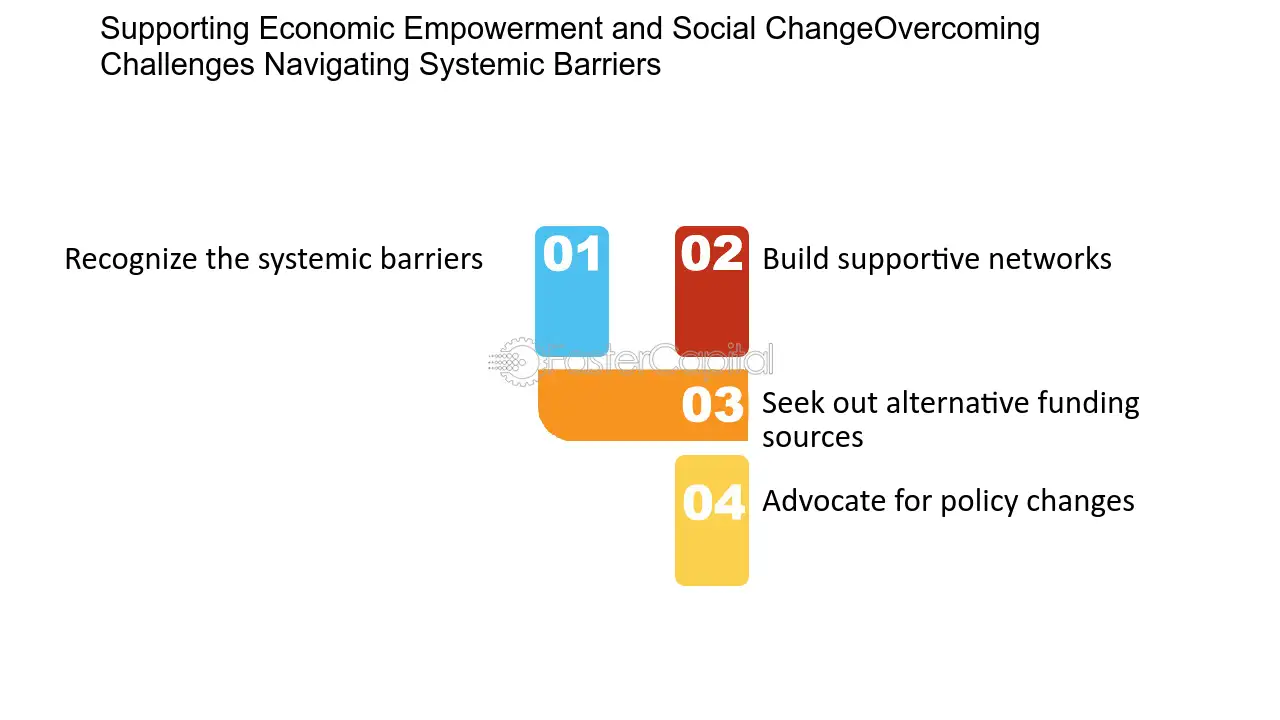
Supporting Economic Empowerment and Social Change:Overcoming Challenges: Navigating Systemic Barriers - Black Owned Businesses: Supporting Economic Empowerment and Social Change
3. Intersectional Entrepreneurship as a Catalyst for Social Change:Overcoming Barriers: Addressing the Challenges Faced by Intersectional Entrepreneurs
1. Lack of Representation and Visibility
One of the major challenges faced by intersectional entrepreneurs is the lack of representation and visibility in the business world. Oftentimes, mainstream media and society tend to promote and highlight entrepreneurs who belong to more privileged groups, such as white males. This lack of representation makes it difficult for intersectional entrepreneurs to gain recognition and attract investors or customers.
For example, a black woman who starts her own tech company may struggle to find venture capital funding due to the stereotype that women and minorities are not capable of excelling in the tech industry. This lack of representation not only hinders their growth but also perpetuates the stereotype that only a certain type of entrepreneur can be successful.
2. Access to Funding and Resources
Access to funding and resources is another significant barrier faced by intersectional entrepreneurs. Studies have shown that women and minority-owned businesses often face difficulties in securing loans or investments compared to their counterparts from more privileged backgrounds. This lack of financial support limits their ability to expand their businesses, hire employees, or invest in new technologies.
For instance, a transgender entrepreneur may face challenges in accessing business loans from traditional financial institutions due to discrimination and bias. This lack of access to funding can hinder their business growth and limit their opportunities to innovate and compete in the market.
3. Stereotypes and Bias
Intersectional entrepreneurs often face stereotypes and biases based on their race, gender, sexual orientation, or other intersecting identities. These stereotypes and biases can manifest in various ways, such as assumptions about their competence, credibility, or leadership abilities.
An example of this can be seen in the experience of a Latina entrepreneur who faces assumptions that she lacks business acumen or leadership skills due to her ethnic background. These stereotypes and biases can create additional barriers, making it harder for intersectional entrepreneurs to gain trust, form partnerships, or access opportunities.
4. Networking and Mentorship Opportunities
Networking and mentorship play a crucial role in the success of any entrepreneur. However, intersectional entrepreneurs may face challenges in finding mentors or building networks that can provide them with guidance, support, and opportunities for growth.
For instance, an LGBTQ+ entrepreneur may struggle to find mentors who can understand and relate to their unique challenges and experiences. This lack of representation in mentorship circles can limit the knowledge and resources available to intersectional entrepreneurs, making it harder for them to navigate the business landscape.
5. Overcoming Intersectional Barriers
Despite the barriers they face, intersectional entrepreneurs have shown resilience and resourcefulness in overcoming challenges and achieving success. They have used various strategies to break through barriers and create meaningful change in their industries.
For example, some intersectional entrepreneurs have created their own support networks and communities, where they can share experiences, advice, and resources. They have also leveraged social media platforms to amplify their voices and showcase their businesses, bypassing traditional gatekeepers and reaching a wider audience.
Additionally, organizations and initiatives focused on supporting intersectional entrepreneurs have emerged, providing mentorship, funding, and educational resources tailored to their specific needs. These efforts are crucial in leveling the playing field and creating a more inclusive and diverse business landscape.
By addressing the barriers faced by intersectional entrepreneurs, we can create a more equitable and inclusive society that values and supports entrepreneurship from all backgrounds. It is essential to recognize and celebrate the unique perspectives and contributions that intersectional entrepreneurs bring, as they have the power to drive social change and break stereotypes in the business world.
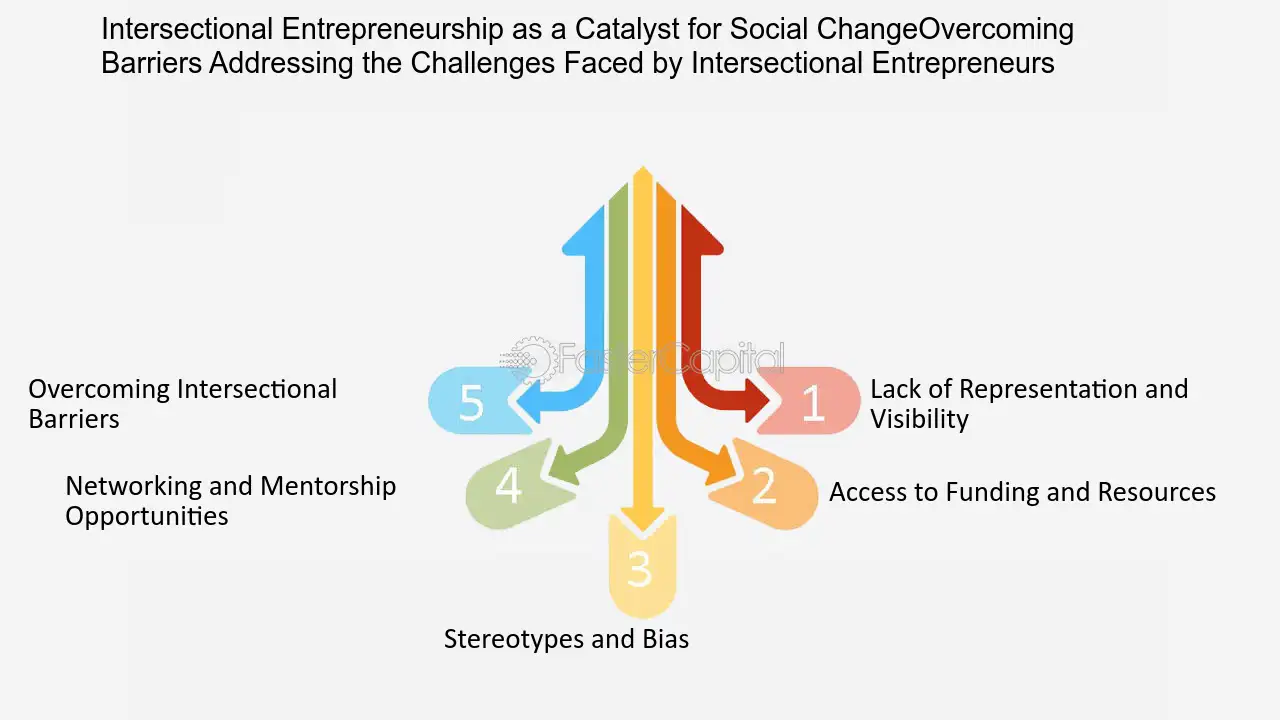
Intersectional Entrepreneurship as a Catalyst for Social Change:Overcoming Barriers: Addressing the Challenges Faced by Intersectional Entrepreneurs - Breaking Stereotypes: Intersectional Entrepreneurship as a Catalyst for Social Change
4. The Role of Green Architecture Entrepreneurs in Combating Climate Change:Overcoming Challenges: Financing and Policy Support for Green Entrepreneurship
1. Understanding the Financing Challenges for Green Entrepreneurship
One of the most significant challenges faced by green entrepreneurs is securing adequate financing for their projects. Traditional financial institutions often hesitate to provide loans or investment capital for ventures that are considered high risk or unconventional. Green entrepreneurs face additional hurdles as their projects typically involve new technologies, untested business models, and longer payback periods. However, there are several strategies that can help overcome these financing challenges.
2. Seeking Alternative Sources of Funding
Green entrepreneurs can explore alternative sources of funding to support their projects. For instance, crowdfunding platforms have gained popularity in recent years and can be a viable option for raising capital. These platforms allow entrepreneurs to present their ideas to a wide audience, who can then contribute financially to support the project. This not only provides the necessary funding but also helps create a community of supporters that can provide valuable feedback and promote the venture.
3. Leveraging Government Support and Incentives
Governments around the world are increasingly recognizing the importance of supporting green entrepreneurship to combat climate change. As a result, many countries offer various subsidies, grants, and tax incentives specifically for green businesses. For example, the United States provides tax credits for renewable energy projects, while Germany offers feed-in tariffs for renewable energy producers. Green entrepreneurs should thoroughly research and take advantage of these government programs to alleviate some of the financial burden.
4. Collaborating with Impact Investors and Venture Capitalists
Impact investors and venture capitalists are specifically interested in funding ventures that have a positive environmental or social impact. Green entrepreneurs can leverage this interest by actively seeking out such investors who align with their mission and values. These investors not only provide financial support but also bring valuable expertise and networks to help scale the venture. Collaborating with impact investors can also enhance the credibility and visibility of the green entrepreneurship project, making it more attractive to other potential investors.
5. Building Strategic Partnerships
Green entrepreneurs can also overcome financing challenges by forming strategic partnerships with established companies or organizations. These partnerships can provide access to additional resources, expertise, and funding opportunities. For example, a green architecture entrepreneur could partner with a construction firm or a renewable energy company to create a mutually beneficial collaboration. Such partnerships not only help secure financing but also enable knowledge sharing and market expansion.
In conclusion, while financing challenges may seem daunting for green entrepreneurs, there are various ways to overcome them. Seeking alternative funding sources, leveraging government support and incentives, collaborating with impact investors, and building strategic partnerships can all contribute to securing the necessary financing. By persevering and exploring these avenues, green entrepreneurs can play a crucial role in building a sustainable future and combating climate change.

The Role of Green Architecture Entrepreneurs in Combating Climate Change:Overcoming Challenges: Financing and Policy Support for Green Entrepreneurship - Building a Sustainable Future: The Role of Green Architecture Entrepreneurs in Combating Climate Change
5. Addressing Resistance to Change and Overcoming Obstacles
Change is often met with resistance, and this resistance can take many forms, from outright hostility to apathy. Resistance can come from any level of an organization, and it can be particularly challenging when it comes from those in positions of power. However, resistance to change is not always a bad thing. It can be an opportunity to learn more about the reasons behind the resistance and to address any underlying issues. Overcoming obstacles requires a combination of understanding the reasons behind the resistance and developing strategies to overcome them.
1. Understand the Reasons for Resistance: The first step in addressing resistance to change is to understand the reasons behind it. Resistance can come from a variety of sources, including fear of the unknown, fear of loss, and a lack of understanding about the benefits of the change. To understand the reasons for resistance, it is important to talk to those who are resistant and to listen to their concerns. This can be done through surveys, focus groups, or one-on-one conversations.
2. Develop a Communication Plan: Once you understand the reasons for resistance, you can develop a communication plan to address them. This plan should be tailored to the specific concerns of those who are resistant and should be designed to help them understand the benefits of the change. The plan should also address any fears or concerns they may have and provide them with the information they need to feel comfortable with the change.
3. Provide Training and Support: Resistance can also come from a lack of understanding about how to implement the change. To overcome this, it is important to provide training and support to those who will be affected by the change. This can include training on new processes or systems, as well as support in the form of coaching or mentoring.
4. Create a Sense of Ownership: People are often resistant to change because they feel like it is being forced upon them. To overcome this, it is important to create a sense of ownership among those who will be affected by the change. This can be done by involving them in the planning process and by giving them a voice in how the change is implemented.
5. Celebrate Successes: Finally, it is important to celebrate successes along the way. Change can be a long and difficult process, and it is important to acknowledge the progress that has been made. This can help to build momentum and to keep people motivated as the change process continues.
Addressing resistance to change and overcoming obstacles requires a combination of understanding the reasons behind the resistance and developing strategies to overcome them. By developing a communication plan, providing training and support, creating a sense of ownership, and celebrating successes, organizations can overcome resistance to change and achieve their goals.
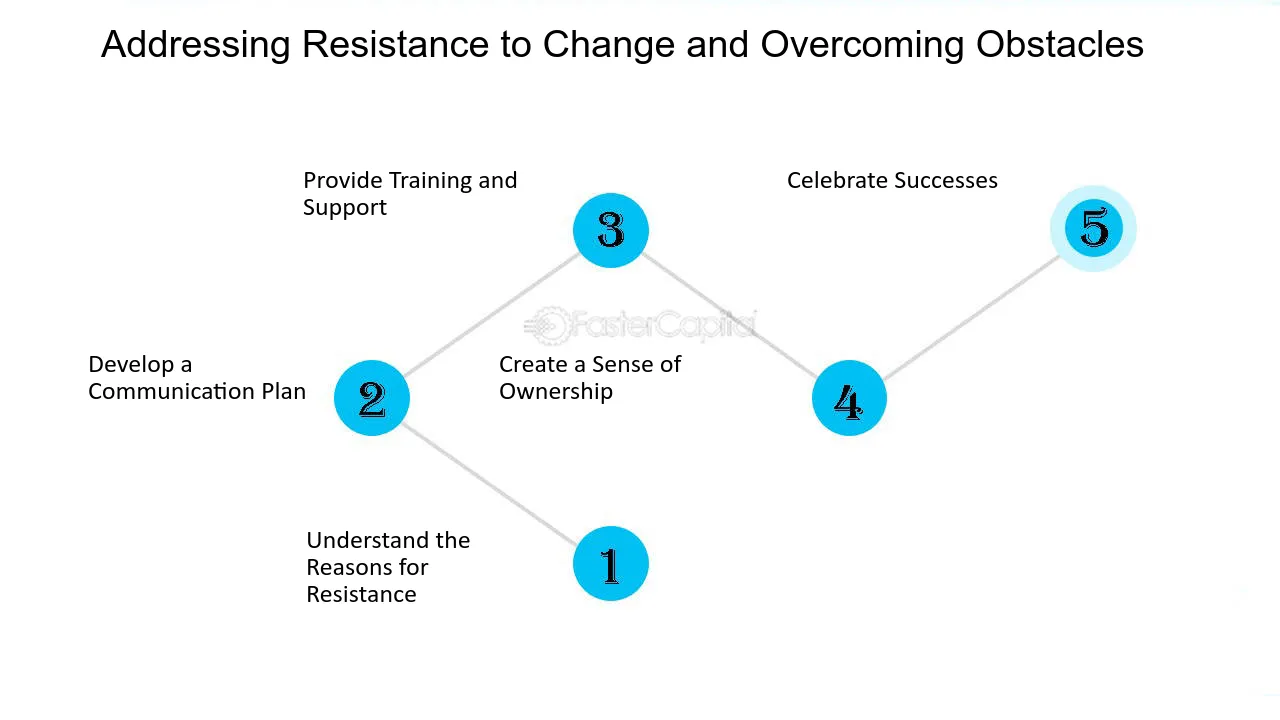
Addressing Resistance to Change and Overcoming Obstacles - Change management: Navigating Change for Seamless Cost Synergy
6. Creating Positive Change:Overcoming Challenges: Navigating the Complexities of Co-operative Entrepreneurship
1. Identifying and Defining the Challenges
Co-operative entrepreneurship is a unique form of business ownership that brings together a group of individuals with a shared vision and mission. While it offers numerous benefits, it also presents its fair share of challenges. The first step in overcoming these challenges is to identify and define them clearly. By understanding the obstacles that lie ahead, co-operative entrepreneurs can develop effective strategies to navigate the complexities they may encounter.
For example, one common challenge faced by co-operative entrepreneurs is the decision-making process. Unlike traditional businesses, where decisions are typically made by a single individual or a small group of executives, co-operatives operate on a democratic basis. This means that every member has a say in the decision-making process, which can sometimes lead to disagreements and delays. By recognizing this challenge, co-operative entrepreneurs can implement strategies such as clear communication channels and consensus-building techniques to ensure efficient decision-making.
2. Building Trust and Collaboration
Building trust and fostering collaboration among co-operative members is crucial for the success of the venture. Co-operative entrepreneurship relies on the active participation and engagement of all members, and a lack of trust or collaboration can hinder progress and productivity.
To overcome this challenge, co-operative entrepreneurs can implement various strategies. For instance, organizing team-building activities and regular meetings can help foster a sense of community and strengthen relationships among members. Additionally, establishing clear roles and responsibilities for each member can enhance accountability and promote a sense of ownership.
3. Managing Finances and Resources
Co-operative entrepreneurship often faces financial and resource management challenges. Co-operatives typically operate on limited budgets, and securing funding can be a daunting task. Moreover, managing resources efficiently is essential to ensure the long-term sustainability of the co-operative.
To address these challenges, co-operative entrepreneurs can explore various avenues for funding, such as grants, loans, or crowdfunding. They can also develop robust financial management systems to track income, expenses, and investments. By carefully managing finances and resources, co-operative entrepreneurs can overcome financial constraints and maximize the impact of their ventures.
4. navigating Legal and regulatory Frameworks
Another complexity faced by co-operative entrepreneurs is navigating the legal and regulatory frameworks specific to co-operatives. Co-operatives are subject to unique laws and regulations that govern their operations, membership, and governance structures. Understanding and complying with these legal requirements can be overwhelming, especially for those new to the co-operative model.
To overcome this challenge, co-operative entrepreneurs can seek legal advice from experts specializing in co-operative law. They can also join co-operative associations or networks that provide support and guidance on legal matters. By staying informed and proactive, co-operative entrepreneurs can navigate the complex legal and regulatory landscape more effectively.
In conclusion, co-operative entrepreneurship offers a powerful platform for creating positive change in society. While it presents its fair share of challenges, these can be overcome through careful planning, effective communication, collaboration, and a proactive approach to problem-solving. By tackling the complexities head-on, co-operative entrepreneurs can harness the potential of co-operative models and make a lasting social impact.
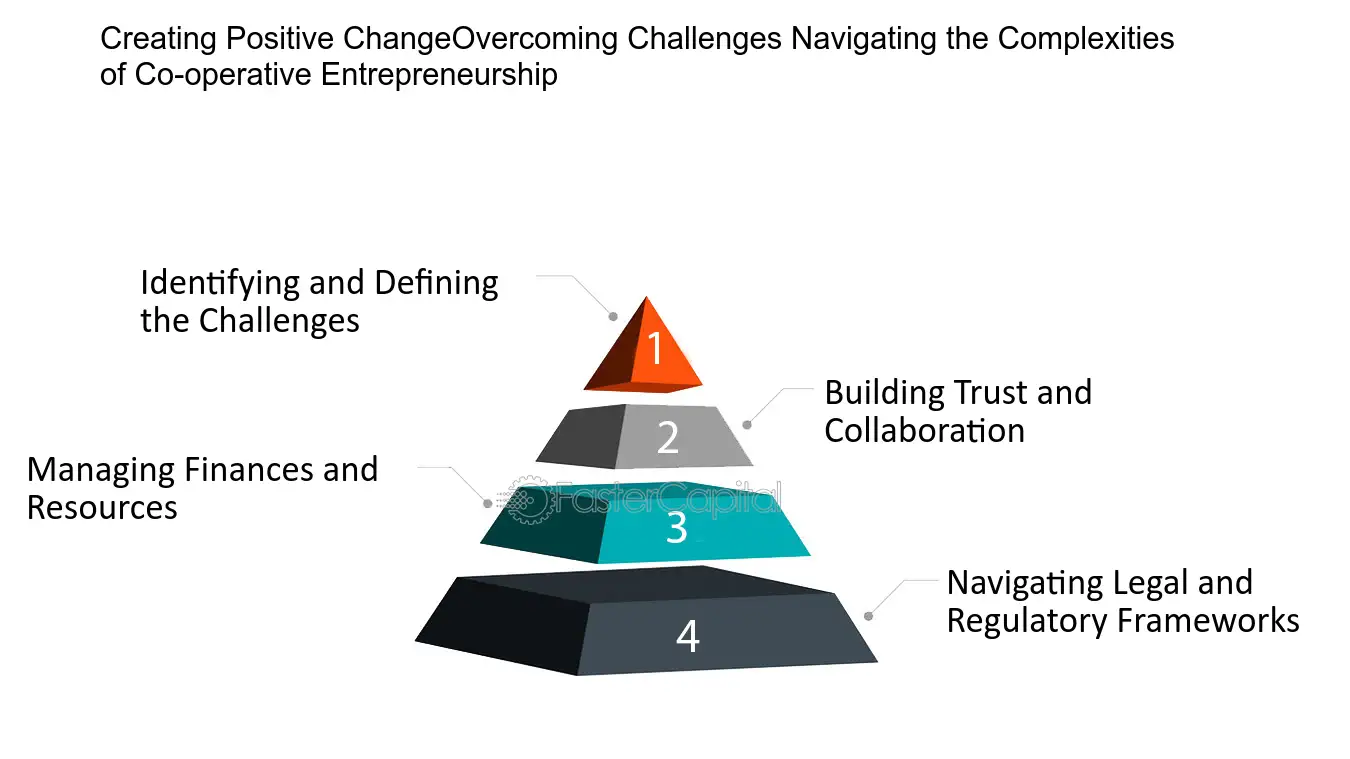
Creating Positive Change:Overcoming Challenges: Navigating the Complexities of Co operative Entrepreneurship - Co operative Entrepreneurship and Social Impact: Creating Positive Change
7. Grassroots Organizing Startups That Inspire Change:Overcoming Challenges: Lessons Learned from Grassroots Organizing
1. Building a Strong Foundation: Start with a Clear Purpose
One of the key lessons learned from grassroots organizing is the importance of having a clear purpose and vision. This involves defining your goals, identifying the issues you want to address, and understanding the impact you want to make. Without a strong foundation, it becomes difficult to rally supporters and create lasting change.
Take, for example, the organization "Youth for Climate Action." This grassroots group was founded by a group of passionate young activists who wanted to raise awareness about climate change and advocate for sustainable policies. By clearly defining their purpose and aligning their actions with their goals, they were able to attract a dedicated group of volunteers and make a significant impact in their community.
2. Building Relationships: Collaboration is Key
Grassroots organizing is all about bringing people together and building strong relationships. Collaboration with like-minded individuals and organizations can amplify your efforts and help you overcome challenges more effectively.
Let's look at the example of the "Community Food Co-op." This grassroots initiative aimed to create a sustainable local food system by supporting local farmers and providing access to fresh, healthy produce for the community. By collaborating with local farmers, businesses, and community organizations, they were able to pool resources, share knowledge, and create a stronger, more resilient movement.
3. Empowering and Engaging the Community: Mobilize Supporters
Grassroots organizing is about empowering and mobilizing the community to take action. This involves engaging supporters, providing opportunities for them to get involved, and empowering them to become leaders in their own right.
The "Education for All" campaign is a great example of community empowerment. This grassroots initiative aimed to ensure equal access to education for all children, regardless of their socio-economic background. By organizing community meetings, workshops, and awareness campaigns, they were able to mobilize parents, teachers, and students to advocate for policy changes and create a more inclusive education system.
4. adapting to Changing circumstances: Flexibility is Key
Grassroots organizing is not without its challenges. One of the most important lessons learned is the need for flexibility and adaptability. Circumstances can change, and it's essential to be able to adjust your strategies and tactics accordingly.
Take the example of the "Digital Advocacy Network." This grassroots organization initially relied heavily on in-person events and community gatherings to raise awareness and mobilize supporters. However, when the COVID-19 pandemic hit and gatherings became impossible, they quickly pivoted to virtual platforms and online campaigns to continue their advocacy work. Their ability to adapt to changing circumstances allowed them to maintain momentum and continue making a difference.
5. Persistence and Resilience: Never Give Up
Perhaps the most important lesson learned from grassroots organizing is the importance of persistence and resilience. creating lasting change takes time, effort, and perseverance. There will be setbacks and challenges along the way, but it's crucial to keep pushing forward.
The "Equal Pay Now" campaign serves as an inspiring example of persistence. This grassroots movement aimed to address the gender pay gap and advocate for equal pay for equal work. Despite facing resistance and setbacks, they persisted in their efforts, organizing protests, lobbying policymakers, and raising awareness about the issue. Their persistence paid off, and they ultimately succeeded in influencing policy changes and closing the pay gap.
In conclusion, grassroots organizing is a powerful tool for creating lasting impact and inspiring change. By building a strong foundation, fostering collaboration, empowering the community, adapting to changing circumstances, and maintaining persistence, grassroots initiatives can overcome challenges and make a significant difference in their communities.
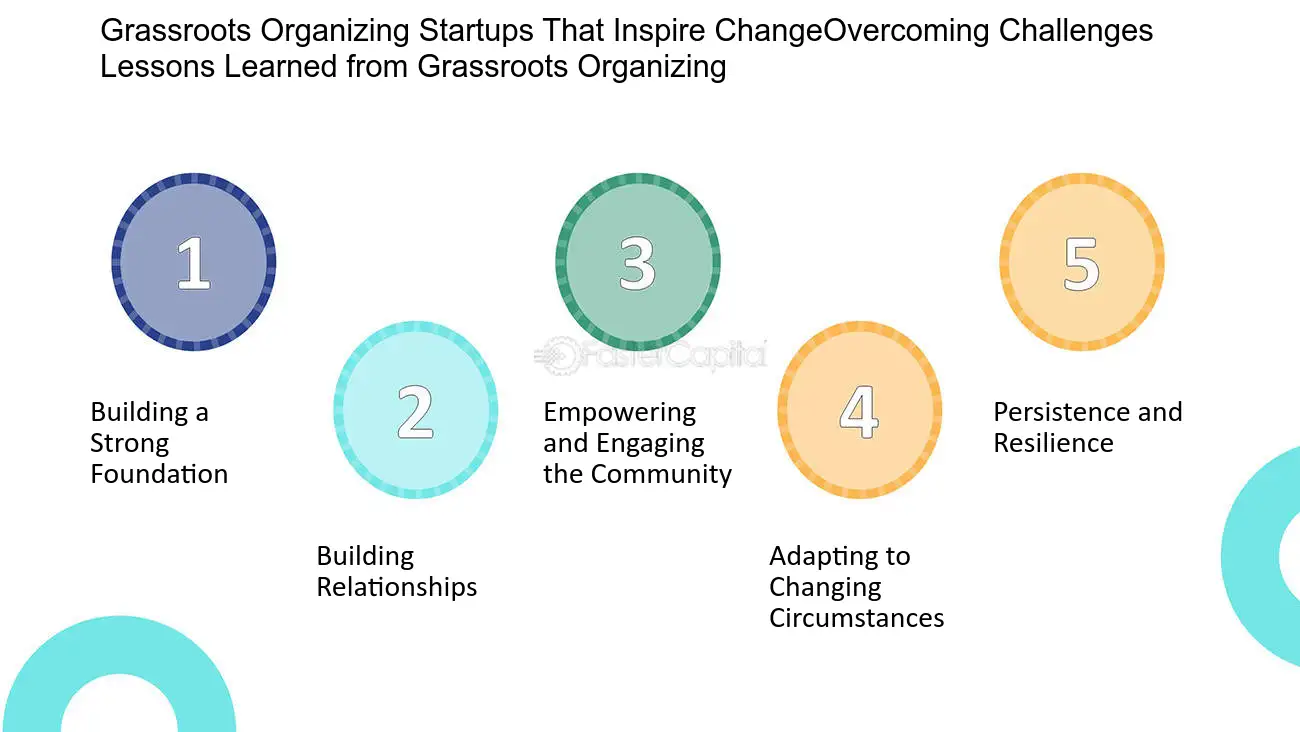
Grassroots Organizing Startups That Inspire Change:Overcoming Challenges: Lessons Learned from Grassroots Organizing - Creating Lasting Impact: Grassroots Organizing Startups That Inspire Change
8. Grassroots Organizing Startups Driving Global Change:Overcoming Challenges: Navigating Obstacles in the Journey from Local to Global
1. Understanding the Global Landscape
When expanding from a local startup to a global entity, it is crucial to have a deep understanding of the global landscape. This includes researching and analyzing the target market, identifying cultural differences and preferences, and comprehending the legal and regulatory frameworks of different countries. For example, a local food delivery startup looking to expand globally would need to consider the dietary preferences, food regulations, and delivery infrastructure of each target market.
2. Adapting to Cultural Differences
One of the biggest challenges in going from local to global is adapting to cultural differences. Each country has its own unique customs, traditions, and ways of doing business. It is essential to be sensitive to these differences and adapt your product or service accordingly. For instance, a clothing brand expanding internationally would need to consider cultural norms around modesty, fashion trends, and sizing preferences in order to successfully cater to the global market.
3. Overcoming Language Barriers
Language barriers can pose a significant challenge when expanding internationally. Communication is key in building relationships with customers, partners, and suppliers. Overcoming language barriers can be achieved by hiring local staff who are fluent in the target market's language, utilizing professional translation services, or developing multilingual customer support systems. For example, a software company expanding globally would need to ensure that their product is available in multiple languages and that customer support is provided in the local language.
4. Establishing Trust and Building Relationships
Building trust and establishing relationships is crucial for success in the global market. It is important to invest time and effort into building relationships with local partners, suppliers, and customers. This can be achieved through networking events, attending trade shows, and leveraging existing connections. For instance, a local sustainable energy startup looking to expand globally would need to build relationships with local governments, energy companies, and environmental organizations to establish credibility and gain support.
5. Adapting to Regulatory and Legal Frameworks
Navigating the regulatory and legal frameworks of different countries can be complex and challenging. It is important to understand the local laws, regulations, and compliance requirements in each target market. This may involve consulting with legal experts or partnering with local firms who have expertise in navigating the local business environment. For example, a fintech startup expanding globally would need to comply with financial regulations, data privacy laws, and licensing requirements in each target market.
In conclusion, expanding from a local startup to a global entity comes with its own set of challenges. Understanding the global landscape, adapting to cultural differences, overcoming language barriers, establishing trust and building relationships, and navigating regulatory and legal frameworks are all crucial steps in successfully navigating the journey from local to global. By addressing these challenges head-on and implementing effective strategies, startups can drive global change and make a positive impact on a larger scale.
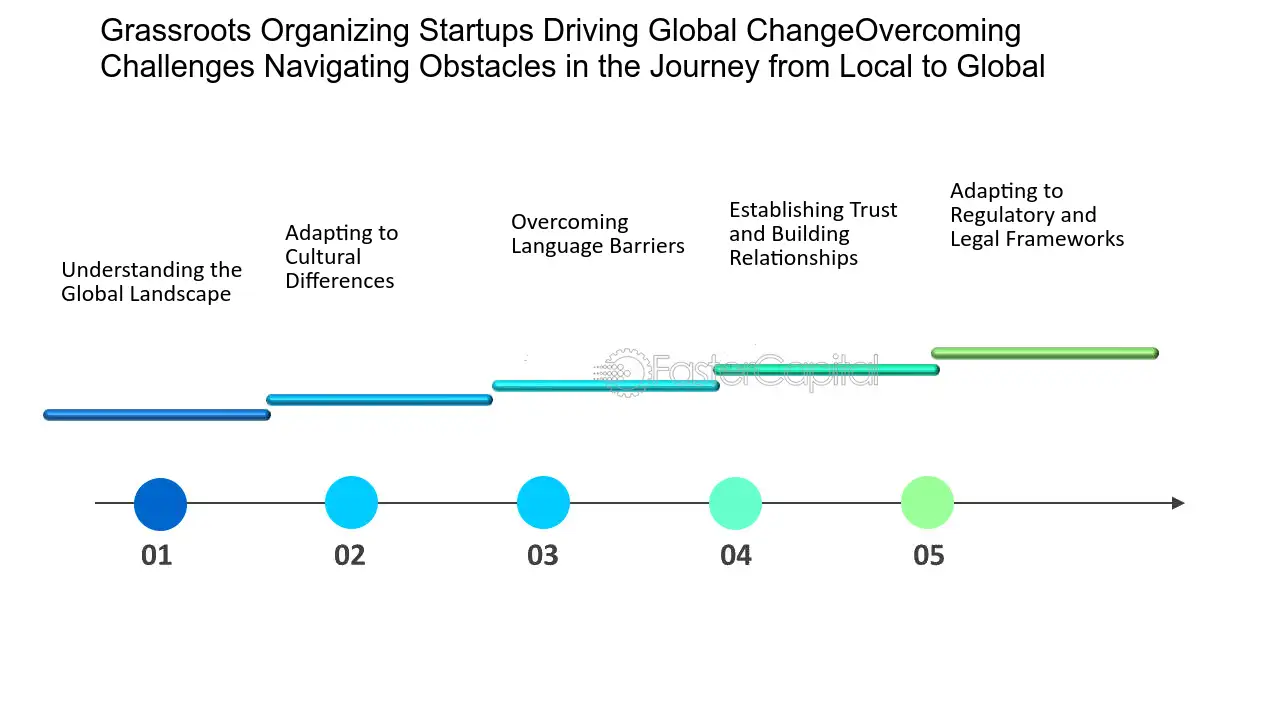
Grassroots Organizing Startups Driving Global Change:Overcoming Challenges: Navigating Obstacles in the Journey from Local to Global - From Local to Global: Grassroots Organizing Startups Driving Global Change
9. The Role of Indigenous Entrepreneurship in Driving Change:Overcoming Challenges: Addressing Barriers to Indigenous Entrepreneurship
1. Lack of access to capital: One of the major barriers faced by Indigenous entrepreneurs is the lack of access to capital. Traditional lending institutions often have stringent requirements that may not align with the unique needs and circumstances of Indigenous businesses. This can make it difficult for aspiring Indigenous entrepreneurs to secure the necessary funding to start or expand their ventures.
For example, many Indigenous communities are located in remote areas that lack the infrastructure and resources typically available in urban centers. This geographical isolation can make it challenging for Indigenous entrepreneurs to access financial institutions or venture capitalists who are more likely to invest in businesses located in major cities. As a result, Indigenous entrepreneurs often have to rely on their personal savings or community-based funding sources to get their businesses off the ground.
2. Limited business networks: building a strong network of business contacts is vital for any entrepreneur, but it can be particularly challenging for Indigenous entrepreneurs who may not have access to the same networks and opportunities as their non-Indigenous counterparts. This can limit their ability to connect with potential investors, suppliers, and customers, hindering their business growth.
For instance, Indigenous entrepreneurs may face difficulties in attending networking events or accessing mentorship programs that are often concentrated in urban areas. This lack of exposure to established business networks can lead to missed opportunities for collaboration and partnership, making it harder for Indigenous entrepreneurs to scale their businesses.
3. Cultural stereotypes and discrimination: Indigenous entrepreneurs often face cultural stereotypes and discrimination that can impede their entrepreneurial journey. These biases can manifest in various ways, such as limited access to markets, biased lending practices, or a lack of recognition for Indigenous-led businesses.
A tangible example of this is the underrepresentation of Indigenous-owned businesses in government procurement contracts. Despite efforts to promote diversity and inclusion, Indigenous entrepreneurs still face barriers when it comes to securing government contracts. This not only limits their growth potential but also perpetuates the cycle of disadvantage that many Indigenous communities face.
4. Lack of business skills and training: Entrepreneurship requires a diverse skill set, ranging from financial management to marketing and sales. However, many Indigenous entrepreneurs may not have had access to formal business education or training opportunities, making it harder for them to navigate the complex world of entrepreneurship.
To address this barrier, various organizations and initiatives have been established to provide Indigenous entrepreneurs with the necessary skills and knowledge. For example, the Indigenous Business Australia (IBA) offers programs and support to help Indigenous entrepreneurs develop their business skills and access capital. Similarly, the National Aboriginal Capital Corporations Association (NACCA) provides training and mentorship programs specifically tailored to the needs of Indigenous entrepreneurs.
By addressing these barriers, we can create an environment that fosters Indigenous entrepreneurship and drives positive change in Indigenous communities. It is crucial to recognize and support the unique challenges faced by Indigenous entrepreneurs and provide them with the resources and opportunities they need to succeed.
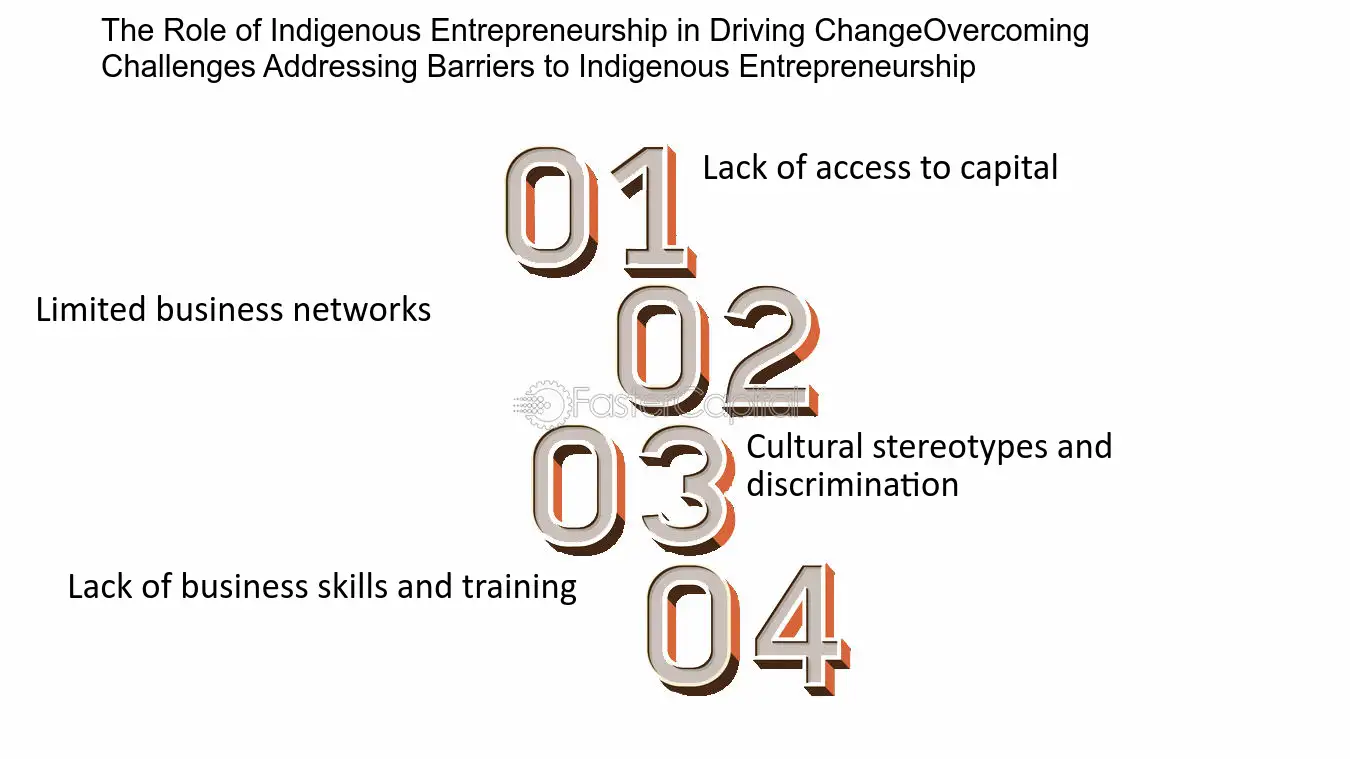
The Role of Indigenous Entrepreneurship in Driving Change:Overcoming Challenges: Addressing Barriers to Indigenous Entrepreneurship - Igniting Innovation: The Role of Indigenous Entrepreneurship in Driving Change
10. The Perfect Marriage for Positive Change:Overcoming Challenges: Navigating the Complexities of Impact Investing and Social Entrepreneurship
1. Identifying the right investment opportunities: One of the biggest challenges in impact investing and social entrepreneurship is identifying the right investment opportunities that align with both financial returns and social impact. With so many organizations and projects vying for funding, it can be overwhelming to navigate through the options and determine which ones are the most promising. However, by conducting thorough research and due diligence, investors can identify innovative and sustainable solutions that address pressing social and environmental issues. For example, an investor interested in renewable energy might look for companies that develop and implement solar energy solutions in underserved communities, providing clean energy access while creating jobs and reducing carbon emissions.
2. Assessing the social and environmental impact: Another challenge in impact investing is accurately measuring and assessing the social and environmental impact of investment choices. Unlike traditional financial metrics, impact measurement requires a more nuanced approach. Investors need to consider factors such as community engagement, stakeholder involvement, and long-term sustainability. Impact measurement tools and frameworks, such as the Global Impact Investing Network's Impact Reporting and Investment Standards (IRIS), can help investors evaluate and compare the impact of different investment opportunities. For instance, an investor supporting a social enterprise focused on education might track metrics like improved literacy rates, school attendance, and student achievement to assess the effectiveness of their investment.
3. Balancing financial returns and social impact: Achieving a balance between financial returns and social impact is often a challenge in impact investing. While the primary goal is to create positive change, investors also expect financial returns on their investments. Finding investments that can deliver both can be complex, as social enterprises often face unique financial challenges. However, there are successful examples of organizations that have managed to strike this balance. For instance, microfinance institutions provide financial services to low-income individuals while also generating profits. By investing in such organizations, investors can support economic empowerment while earning a reasonable return on their investment.
4. building a strong network and collaboration: Collaboration and networking play a crucial role in impact investing and social entrepreneurship. Building strong connections with like-minded individuals, organizations, and policymakers can help overcome challenges and create a more significant collective impact. Investors can join impact investing networks and attend conferences and events to meet potential collaborators and learn from industry experts. Additionally, partnerships between investors, entrepreneurs, and nonprofits can help leverage resources and expertise to tackle complex social and environmental problems. For example, a collaboration between an impact investor, a social entrepreneur, and a local nonprofit could lead to the successful implementation of a project addressing water scarcity in a developing country.
5. Staying informed and adapting to changing landscapes: Impact investing and social entrepreneurship are dynamic fields that continuously evolve as new challenges and opportunities emerge. staying informed about the latest trends, policy changes, and innovative solutions is essential for overcoming challenges. Investors should regularly update their knowledge through industry publications, research reports, and attending workshops or webinars. Additionally, being adaptable and open to adjusting investment strategies based on the changing landscape is crucial. For instance, the COVID-19 pandemic highlighted the need for investments in healthcare and social safety nets, prompting many impact investors to refocus their portfolios to address these urgent needs.
In conclusion, navigating the complexities of impact investing and social entrepreneurship requires careful consideration and strategic decision-making. By identifying the right investment opportunities, assessing impact, balancing financial returns and social impact, building a strong network, and staying informed, investors can overcome challenges and contribute to positive change in society.
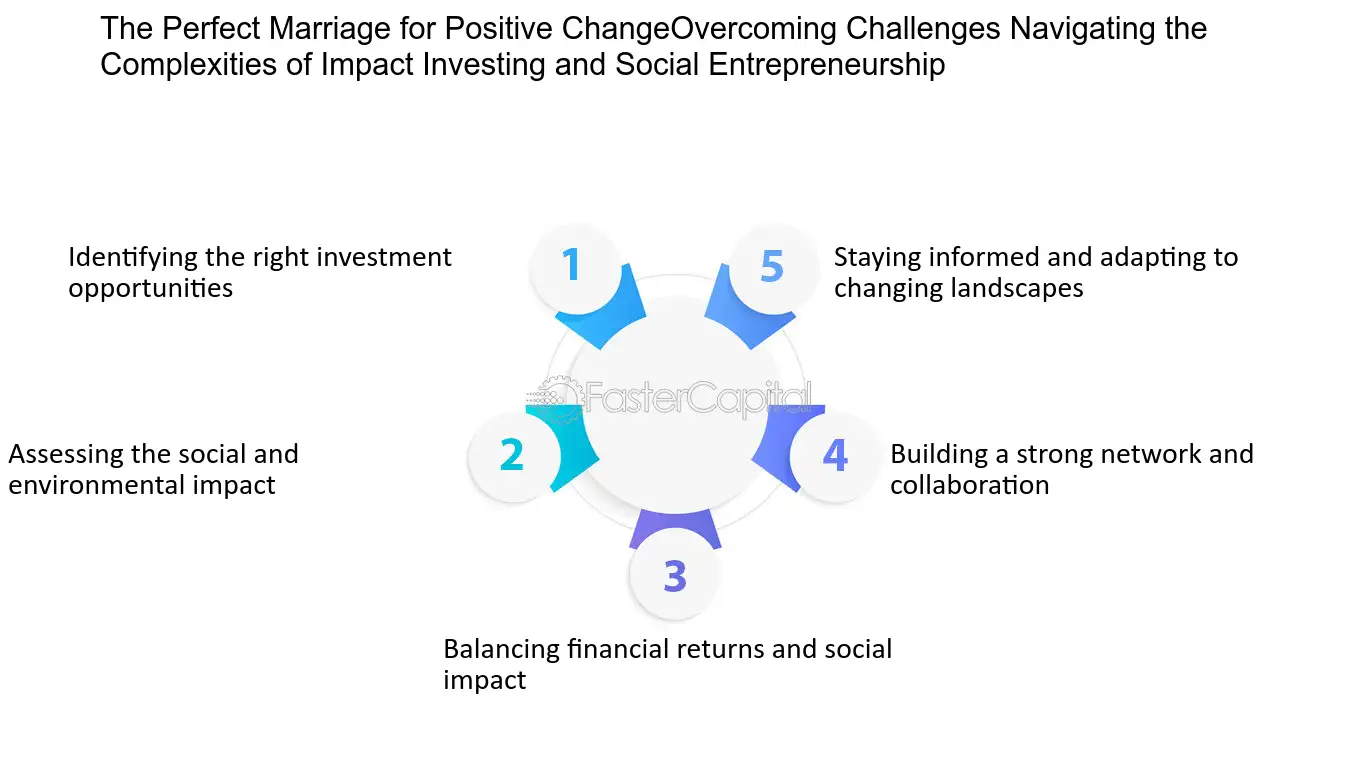
The Perfect Marriage for Positive Change:Overcoming Challenges: Navigating the Complexities of Impact Investing and Social Entrepreneurship - Impact Investing and Social Entrepreneurship: The Perfect Marriage for Positive Change
11. The Role of Diverse Founder Initiatives in Driving Change:Overcoming Challenges: Addressing Bias and Discrimination in Entrepreneurship
1. Recognizing and acknowledging bias and discrimination: The first step towards addressing bias and discrimination in entrepreneurship is to recognize that it exists. Many entrepreneurs may not even be aware of the biases and discriminatory practices that exist within their own organizations or in the broader business landscape. It is crucial for founders to educate themselves about the different forms of bias and discrimination that can affect their business, such as gender, race, age, and socioeconomic background.
For example, a study conducted by harvard Business review found that investors are more likely to fund ventures led by individuals who resemble themselves in terms of gender, race, and educational background. This unconscious bias can prevent entrepreneurs from diverse backgrounds from accessing the necessary funding to start or grow their businesses.
2. Creating an inclusive company culture: Once biases and discriminatory practices have been identified, it is important for entrepreneurs to create an inclusive company culture that promotes diversity and equality. This involves fostering an environment where all employees feel valued, respected, and included, regardless of their background.
For instance, entrepreneurs can implement diversity training programs that raise awareness about bias and discrimination and provide tools for employees to address and challenge these issues. By actively promoting inclusivity, entrepreneurs can ensure that their organizations attract and retain a diverse pool of talent, which can lead to increased creativity, innovation, and ultimately, business success.
3. Implementing diverse hiring practices: To overcome bias and discrimination, entrepreneurs need to rethink their hiring practices and actively seek out diverse candidates. This can include establishing partnerships with organizations that focus on recruiting underrepresented groups, or implementing blind hiring techniques that remove identifying information from resumes and focus solely on skills and qualifications.
For example, the tech company Airbnb recognized the need to address bias in its hiring process and implemented a policy of blind screening for job applicants. By removing the applicants' names, gender, and educational background from their resumes, the company aimed to focus solely on the skills and experiences of candidates. This approach helped Airbnb increase the diversity of its workforce and foster a more inclusive culture.
4. Building diverse networks and mentorship programs: Another important strategy for overcoming bias and discrimination in entrepreneurship is to build diverse networks and mentorship programs. By connecting with individuals from different backgrounds and experiences, entrepreneurs can gain valuable perspectives and insights that can help them challenge their own biases and drive positive change within their organizations.
For instance, organizations like Black Women Talk Tech and Latinx Startup Alliance provide platforms for entrepreneurs from underrepresented communities to connect, share resources, and access mentorship opportunities. These initiatives not only provide support and guidance to diverse founders but also create a network of individuals who can advocate for and amplify their voices within the entrepreneurial ecosystem.
In conclusion, addressing bias and discrimination in entrepreneurship requires a proactive and concerted effort from founders. By recognizing and acknowledging bias, creating an inclusive company culture, implementing diverse hiring practices, and building diverse networks and mentorship programs, entrepreneurs can contribute to a more equitable and innovative business landscape. Embracing diversity and challenging discriminatory practices not only benefits individual entrepreneurs but also leads to a more inclusive and prosperous society as a whole.
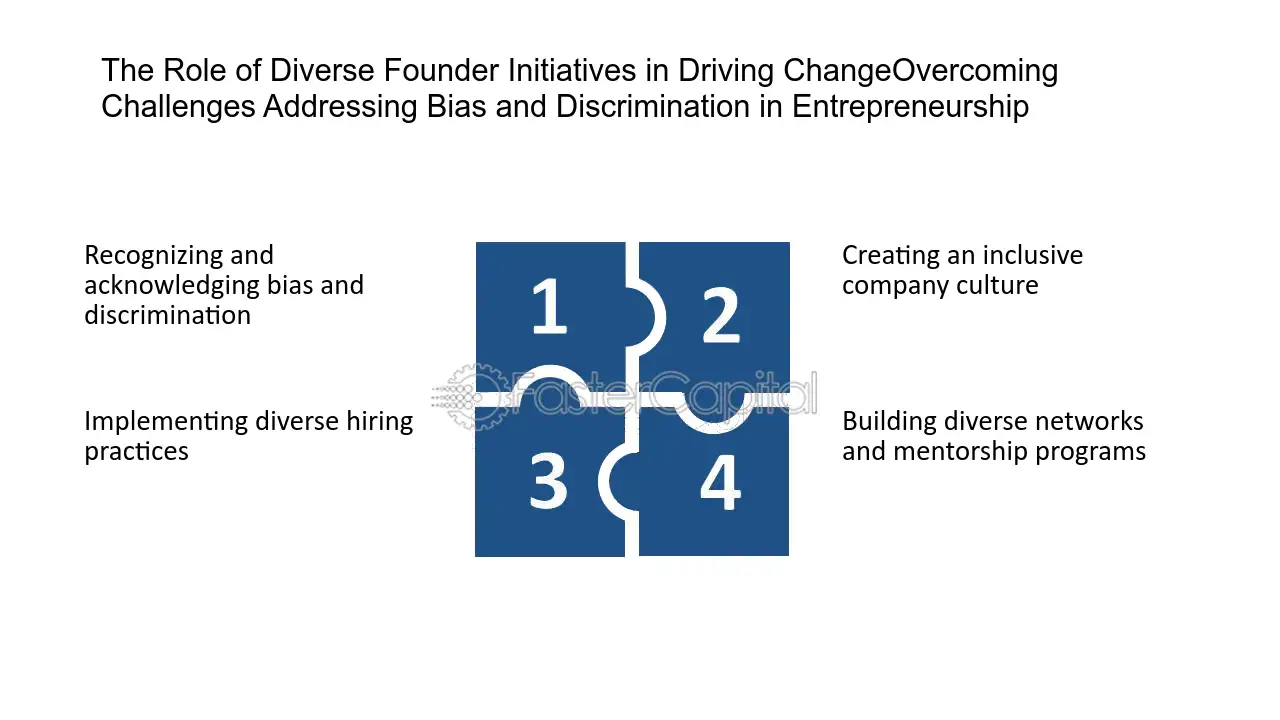
The Role of Diverse Founder Initiatives in Driving Change:Overcoming Challenges: Addressing Bias and Discrimination in Entrepreneurship - Inclusion and Innovation: The Role of Diverse Founder Initiatives in Driving Change
12. Paving the Way for Social Change:Overcoming Challenges: Addressing Systemic Injustices in Entrepreneurship
1. Recognizing the Existence of Systemic Injustices
In order to address systemic injustices in entrepreneurship, it is crucial to first acknowledge their existence. This means understanding that certain groups, such as women, people of color, and individuals from disadvantaged backgrounds, face unique challenges and barriers when it comes to starting and growing their own businesses. By recognizing these systemic injustices, we can begin to develop strategies and solutions to overcome them.
2. Providing Access to Resources and Opportunities
One of the key challenges faced by marginalized groups in entrepreneurship is a lack of access to resources and opportunities. For example, women often struggle to secure funding for their businesses, with studies showing that female-led startups receive significantly less venture capital compared to their male counterparts. To address this injustice, it is important to provide equal access to funding, mentorship programs, and networking opportunities for all entrepreneurs, regardless of their background.
3. Promoting Diversity and Inclusion in Entrepreneurship
Another crucial step in addressing systemic injustices is promoting diversity and inclusion within the entrepreneurial ecosystem. This involves creating an environment where individuals from all backgrounds feel welcome and supported. For instance, incubators and accelerators can actively seek out and support entrepreneurs from underrepresented groups, while also implementing inclusive policies and practices that prioritize diversity.
4. Breaking Down Biases and Stereotypes
Biases and stereotypes can act as significant barriers for marginalized groups in entrepreneurship. Whether it's gender stereotypes that assume women are less capable in business or racial biases that undermine the potential of entrepreneurs of color, these prejudices can hold individuals back. Overcoming these challenges requires a concerted effort to challenge and dismantle these biases, both at an individual and systemic level. This can be achieved through education, awareness campaigns, and inclusive hiring practices.
5. Creating Supportive Networks and Communities
Entrepreneurship can be a lonely and isolating journey, particularly for individuals who do not have access to strong support networks. By creating supportive communities and networks, entrepreneurs from marginalized backgrounds can find mentorship, guidance, and emotional support. For example, organizations and initiatives can be established to connect entrepreneurs from underrepresented groups, providing them with a sense of belonging and the opportunity to share experiences and resources.
6. empowering Entrepreneurs through education and Training
Equipping entrepreneurs with the necessary knowledge and skills is essential for overcoming systemic injustices. Providing access to quality education and training programs can level the playing field and empower individuals to succeed in their entrepreneurial endeavors. This could include offering workshops, courses, and mentorship programs specifically tailored to the needs of marginalized entrepreneurs.
7. Amplifying Success Stories and Role Models
Highlighting success stories and role models from underrepresented groups can inspire and motivate aspiring entrepreneurs. By showcasing the achievements of individuals who have overcome systemic injustices and achieved entrepreneurial success, we can challenge stereotypes and demonstrate that entrepreneurship is a viable path for all. Media outlets, conferences, and events can play a vital role in amplifying these stories and providing platforms for marginalized entrepreneurs to share their experiences.
In conclusion, addressing systemic injustices in entrepreneurship requires a multifaceted approach that involves recognizing the existence of these challenges, providing access to resources and opportunities, promoting diversity and inclusion, breaking down biases and stereotypes, creating supportive networks, empowering through education and training, and amplifying success stories. By taking these steps, we can pave the way for inclusive entrepreneurship and drive positive social change.
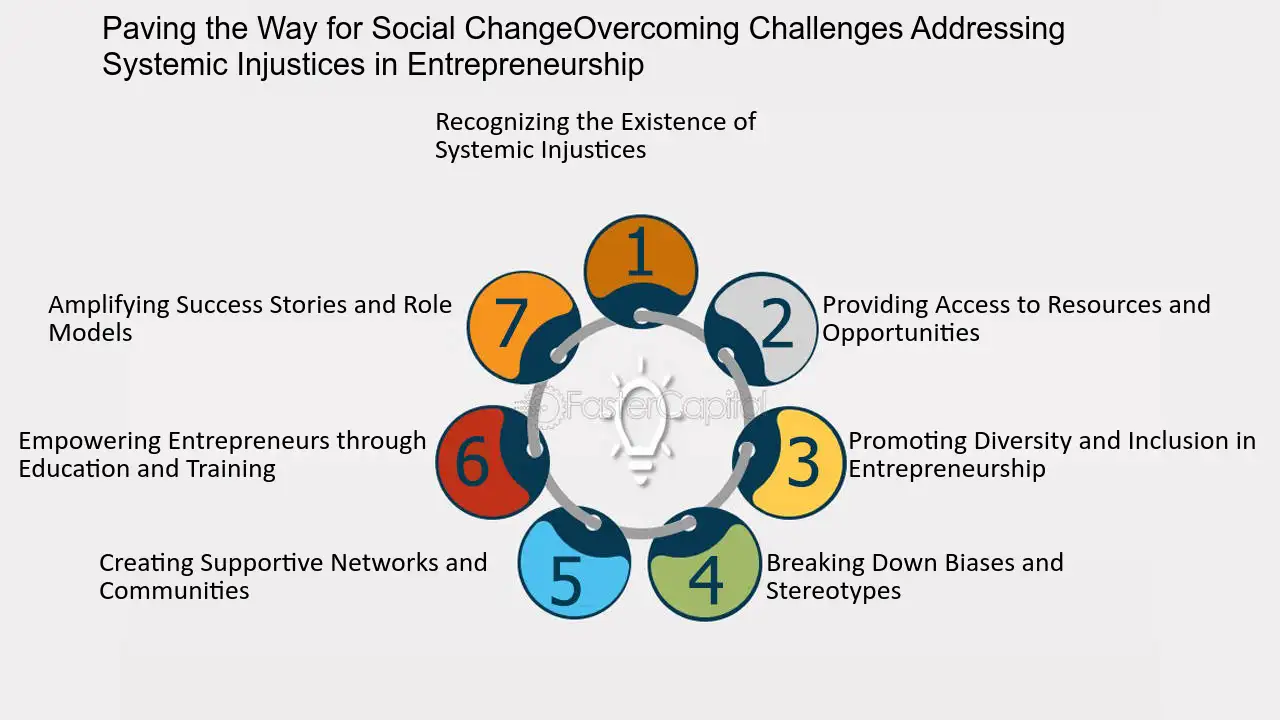
Paving the Way for Social Change:Overcoming Challenges: Addressing Systemic Injustices in Entrepreneurship - Inclusive Entrepreneurship: Paving the Way for Social Change
13. Breaking Barriers and Inspiring Change:Overcoming Language Barriers: The Role of Technology in Enhancing Accessibility
1. Translation Apps: Breaking Down Language Barriers
One of the most apparent ways technology has enhanced accessibility in overcoming language barriers is through translation apps. These apps have revolutionized the way we communicate with people from different linguistic backgrounds while traveling. Whether you're in a foreign country or interacting with international tourists in your own city, translation apps like Google Translate or iTranslate can provide real-time translations, enabling effective communication despite language differences.
For example, imagine you're a hotel owner in a popular tourist destination, and a guest from a non-English speaking country approaches your front desk. In the past, you might have struggled to understand each other, leading to frustration and miscommunication. However, with the help of a translation app, you can simply input your message, and the app will provide an accurate translation in the guest's language. This not only enhances the overall guest experience but also fosters a sense of inclusivity, making your establishment more welcoming to travelers from diverse backgrounds.
2. Sign Language Interpretation: Bridging the Gap for the Deaf Community
Language barriers are not limited to spoken languages alone. Deaf individuals also face unique challenges when it comes to communication. Thankfully, technology has stepped in to bridge this gap as well. Videoconferencing platforms like Skype and Zoom, coupled with sign language interpretation services, have made it possible for the deaf community to engage in conversations and access information more easily.
Consider a scenario where a deaf traveler wants to explore a popular tourist attraction but encounters difficulties in communicating with the staff. By utilizing videoconferencing technology and sign language interpretation services, the staff can communicate directly with the traveler, ensuring a seamless experience. This technology not only enhances accessibility but also promotes inclusivity by breaking down communication barriers for the deaf community.
3. Speech Recognition Technology: Enabling Effortless Communication
Speech recognition technology has revolutionized the way we interact with devices and has become an invaluable tool in overcoming language barriers. Virtual assistants like Siri, Alexa, and Google Assistant can understand and respond to voice commands, making communication more accessible for individuals with limited language proficiency.
For instance, imagine a non-English speaking traveler trying to navigate a new city using a ride-sharing app. Instead of struggling to communicate their destination to the driver, they can simply use voice commands to input their desired location, and the app will provide the necessary information to the driver. This not only saves time but also eliminates potential misunderstandings due to language barriers.
4. Augmented Reality Translation: Enhancing Cultural Experiences
Augmented reality (AR) technology has opened up new possibilities for overcoming language barriers by providing real-time translations in a visually immersive manner. Apps like Word Lens and Google Translate's AR feature use the smartphone's camera to overlay translated text onto real-world objects, helping users understand signs, menus, and other written content in foreign languages.
For example, imagine visiting a foreign museum where all the exhibits are labeled in the local language. With an AR translation app, you can simply point your smartphone camera at the labels, and the app will instantly translate them into your preferred language. This technology not only enhances the cultural experience but also empowers travelers to explore and learn without being hindered by language barriers.
In conclusion, technology has played a pivotal role in enhancing accessibility and breaking down language barriers in the realm of inclusive tourism ventures. From translation apps to sign language interpretation services, speech recognition technology to augmented reality translation, there are numerous tools available that enable effective communication and foster inclusivity. embracing these technological advancements can help create a more accessible and inclusive travel experience for all individuals, regardless of their linguistic backgrounds.

Breaking Barriers and Inspiring Change:Overcoming Language Barriers: The Role of Technology in Enhancing Accessibility - Inclusive Tourism Ventures: Breaking Barriers and Inspiring Change
14. A Catalyst for Economic Growth and Social Change:Overcoming Barriers: Access to Capital and Resources
1. Identifying Barriers: Access to Capital and Resources
Indigenous entrepreneurs face unique challenges when it comes to accessing capital and resources. These barriers can hinder their ability to start and grow successful businesses. However, there are strategies and initiatives in place that aim to overcome these obstacles and create opportunities for Indigenous entrepreneurs to thrive.
2. Limited Financial Resources
One of the main barriers Indigenous entrepreneurs face is a lack of financial resources. Many Indigenous communities have historically faced economic disadvantages, which can make it difficult for individuals to access traditional funding sources such as banks or venture capitalists. This limited access to capital can hinder the growth and development of Indigenous-owned businesses.
To overcome this barrier, various organizations have been established to provide financial support specifically tailored to the needs of Indigenous entrepreneurs. For example, the National Aboriginal Capital Corporations Association (NACCA) in Canada offers loans and business support services to Indigenous entrepreneurs. These organizations understand the unique challenges faced by Indigenous entrepreneurs and provide resources to help them succeed.
3. Limited Access to Networks and Markets
Another barrier for Indigenous entrepreneurs is limited access to networks and markets. Building connections and finding customers can be challenging, especially for those operating in remote or marginalized communities. Without access to wider markets, Indigenous entrepreneurs may struggle to scale their businesses and reach their full potential.
To address this barrier, initiatives like Indigenous business networks have emerged to connect Indigenous entrepreneurs with opportunities and resources. These networks provide a platform for Indigenous entrepreneurs to collaborate, share knowledge, and access new markets. For instance, the Canadian Council for Aboriginal Business (CCAB) organizes networking events and connects Indigenous entrepreneurs with corporations looking to support Indigenous businesses.
4. Cultural and Language Barriers
Cultural and language barriers can also pose challenges for Indigenous entrepreneurs. traditional business models may not align with Indigenous values and practices, making it difficult to navigate the business world. Additionally, language barriers can limit access to resources and information necessary for business success.
To overcome these barriers, culturally sensitive entrepreneurship programs and training have been developed. These programs provide guidance and support tailored to the cultural context of Indigenous entrepreneurs. For example, the First Nations University of Canada offers an Indigenous Business and Entrepreneurship program that integrates Indigenous culture and business practices.
5. Government Support and Partnerships
Governments have recognized the importance of supporting Indigenous entrepreneurship and have implemented various programs and policies to address these barriers. For example, in Canada, the federal government has established the Indigenous Entrepreneurship Initiative, which provides funding and support for Indigenous entrepreneurs. Additionally, partnerships between government agencies, Indigenous organizations, and private sector companies have been formed to create opportunities and support the growth of Indigenous businesses.
In conclusion, while Indigenous entrepreneurs face significant barriers when it comes to accessing capital and resources, there are strategies and initiatives in place to overcome these challenges. By providing tailored financial support, fostering networks and partnerships, and addressing cultural and language barriers, Indigenous entrepreneurs can be empowered to succeed and contribute to economic growth and social change in their communities.
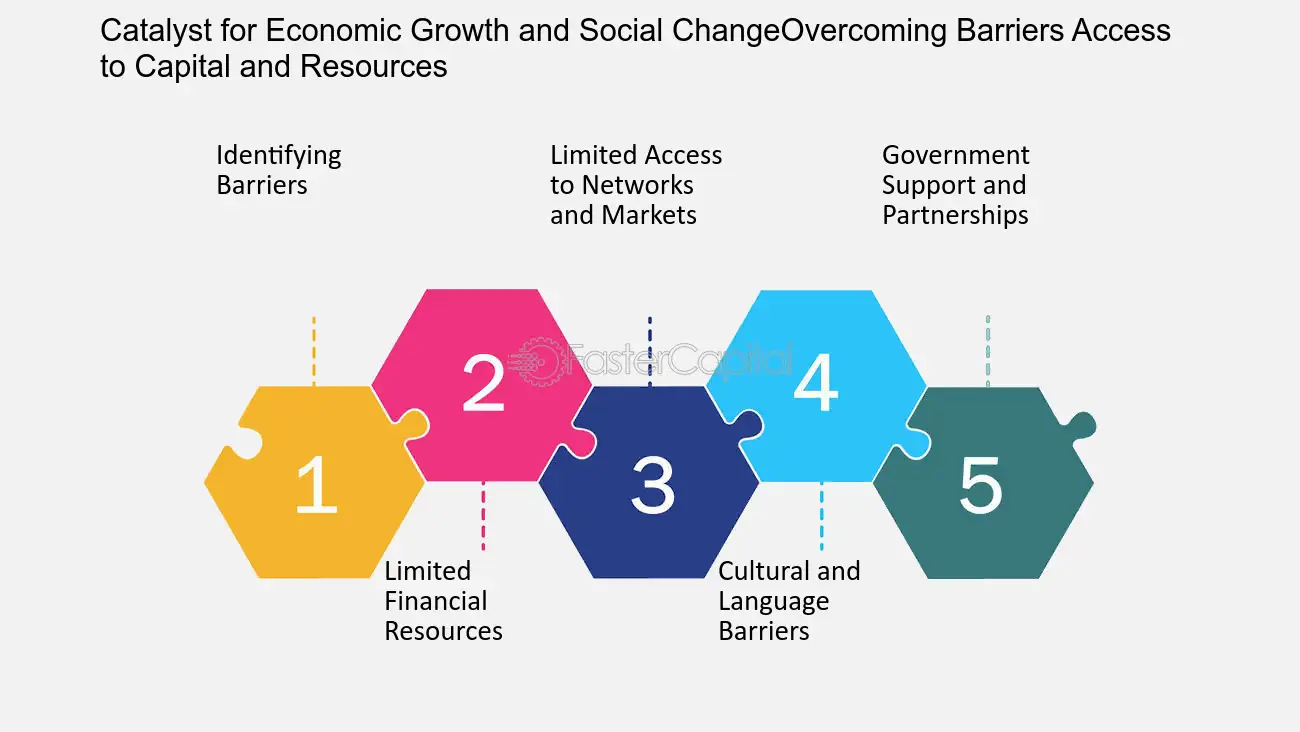
A Catalyst for Economic Growth and Social Change:Overcoming Barriers: Access to Capital and Resources - Indigenous Entrepreneurship: A Catalyst for Economic Growth and Social Change
15. Adapting to Change and Overcoming Challenges
In order to lead a successful firm, a leader must be able to adapt to change and overcome challenges. Change is inevitable, and it is important for leaders to be flexible and adjust their plans accordingly. Challenges can arise at any time, and it is the leader's responsibility to guide their team through these obstacles. Adapting to change and overcoming challenges requires strong leadership skills, such as effective communication, strategic planning, and the ability to motivate and inspire others. It is not always easy, but with the right mindset and approach, leaders can navigate through any situation.
1. Communication is Key
Effective communication is essential when it comes to adapting to change and overcoming challenges. Leaders must communicate with their team openly and honestly, ensuring that everyone is on the same page. This means providing clear instructions and feedback, as well as listening to the concerns and ideas of others. When everyone is working towards a common goal, it is easier to navigate through challenging situations.
2. Strategic Planning
Leaders must have a strategic plan in place in order to adapt to change and overcome challenges. This means anticipating potential problems and having a backup plan in case things don't go as expected. It is important to be proactive rather than reactive, and to have contingency plans in place. By thinking ahead and planning for the unexpected, leaders can lead their team through any situation.
3. Motivate and Inspire
During times of change and challenge, it is important for leaders to motivate and inspire their team. This means setting a positive example and leading by example. Leaders must be confident and optimistic, even in the face of adversity. By staying positive and encouraging others, leaders can boost morale and keep their team motivated.
4. Embrace Change
Change can be scary, but it is important for leaders to embrace it. By doing so, they can help their team see the potential benefits and opportunities that change can bring. Leaders must be open-minded and willing to try new things, even if they are outside of their comfort zone. By embracing change, leaders can lead their team towards success.
Adapting to change and overcoming challenges is essential for effective leadership. By communicating effectively, planning strategically, motivating and inspiring others, and embracing change, leaders can guide their team through any situation. It is not always easy, but with the right mindset and approach, leaders can navigate through any obstacle and lead their firm towards success.
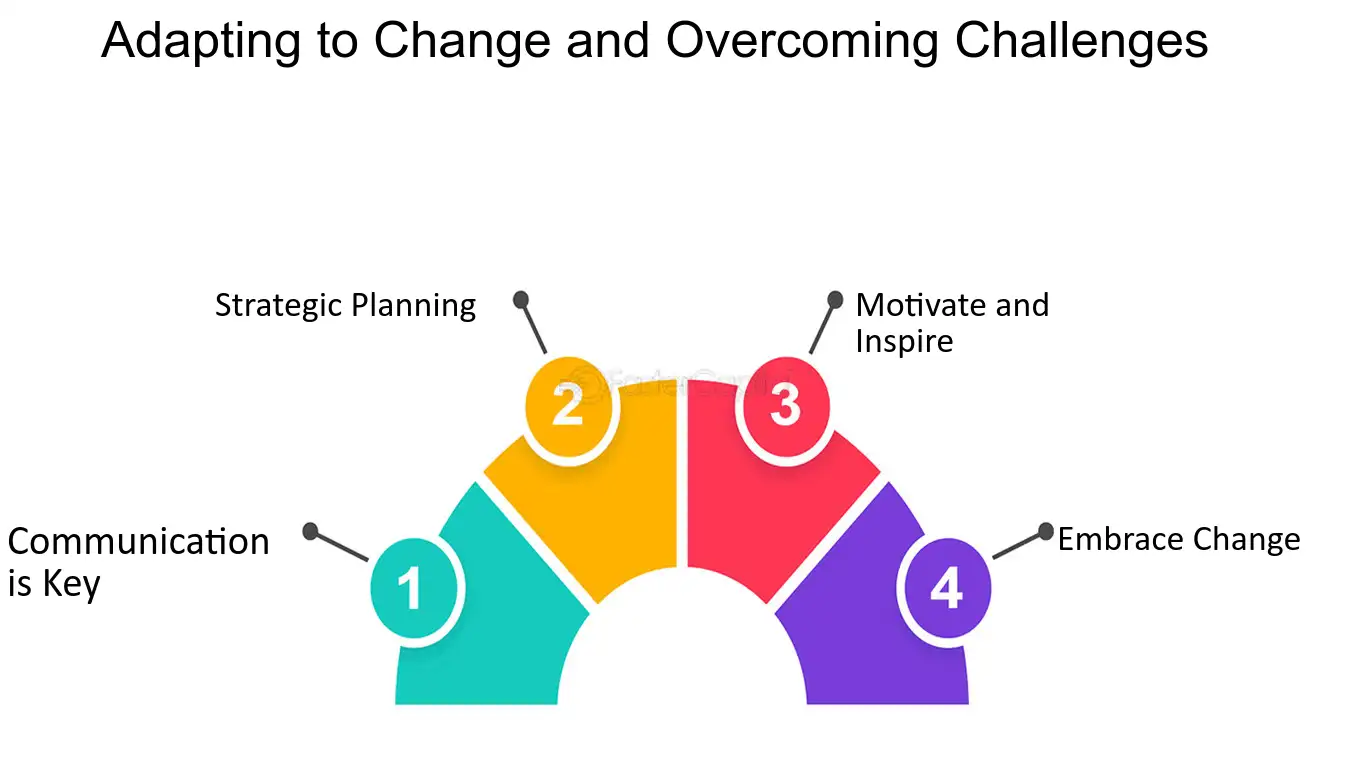
Adapting to Change and Overcoming Challenges - Leadership: Effective Leadership: Guiding Your Firm Towards Success
16. Managing Change and Overcoming Resistance
Change can often be met with resistance, making effective change management crucial during a transition. Here are strategies to manage change and overcome resistance:
1. Engage employees early: Involve employees in the transition process from the start. Explain the reasons behind the change and how it will impact them. Encourage their input and address any concerns.
2. Communicate the benefits: Clearly communicate the benefits of the transition to employees. Help them understand how it aligns with their career goals and the long-term success of the company.
3. Provide training and support: Equip employees with the skills and knowledge needed to adapt to the changes. Offer training programs and provide ongoing support to address any challenges they may face.
4. Address resistance: Actively listen to employee concerns and address them empathetically. Understand the underlying reasons for resistance and work with employees to find solutions.
5. Celebrate successes: Recognize and celebrate milestones and successes throughout the transition process. This helps maintain momentum and boosts employee morale.
By effectively managing change and addressing resistance, you create an environment where employees are more willing to embrace the transition. This paves the way for a smoother and more successful transition process.
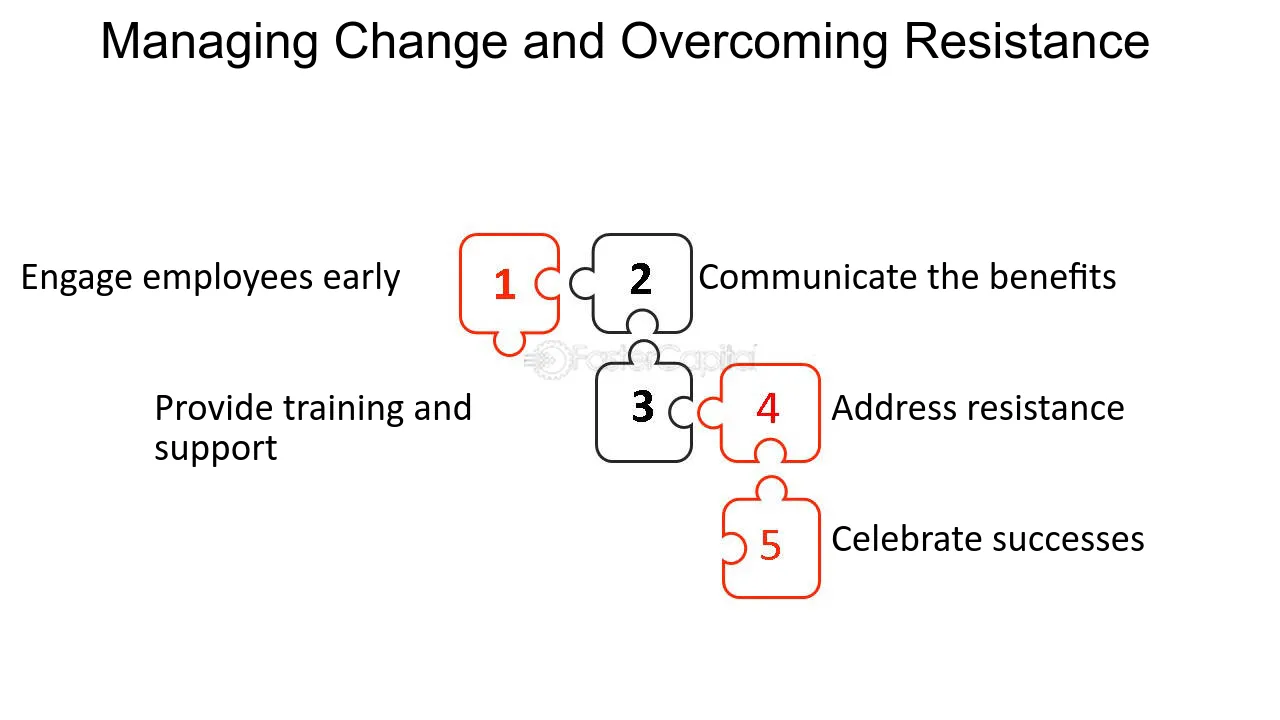
Managing Change and Overcoming Resistance - Strategies for Successfully Transitioning Your Company
17. Making Time for Change Overcoming the Obstacles to Personal Change
Making time for change can be a daunting task for many people in todays busy world. With work, family, and other obligations taking up much of our time, it can feel impossible to make time for personal change. But change is essential to growth. Without it, we are unable to evolve and reach our true potential. The key is finding the right balance between our commitments and the time we need to make meaningful changes in our lives.
When it comes to making time for change, the first step is to identify any obstacles that may be in the way. Common obstacles include lack of motivation, fear of failure, and lack of resources. Its important to be honest with yourself when assessing these obstacles and to set realistic goals that are achievable with the resources you have available. If a particular obstacle seems insurmountable, consider enlisting the help of friends or professionals who can offer support and guidance.
The next step is to create a plan for making time for personal change. This will involve scheduling time for yourself each day or week that is dedicated solely to your own growth and development. This can include anything from reading self-help books to attending classes or workshops related to your goals. Its important to make this time a priority and stick to it - even if it means sacrificing some other activities or responsibilities.
Finally, its important to be mindful throughout this process and to recognize when you are feeling overwhelmed. Its okay to take breaks or adjust your plan if needed. Making time for change can be difficult, but the rewards are worth it. Once youve made a commitment to yourself and put in the hard work, you will begin to see real results in your life.
Overall, making time for change requires an investment of both time and energy. But if you are able to identify any obstacles that may be blocking your progress and create an effective plan for yourself, you will be well on your way to achieving the personal growth you desire. With dedication and perseverance, you can make meaningful changes in your life and reach your full potential.
Need support to apply for loans?
FasterCapital helps you in applying for business loans on a global scale, preparing your documents and connecting you with lenders
18. Adapting to change and overcoming challenges
Business development professionals operate in a dynamic and ever-changing environment. The ability to adapt to change and overcome challenges is crucial for success. Here's how you can effectively navigate through change and challenges:
1. Stay agile and flexible: Embrace change and be willing to adapt your strategies and approaches. This requires an open mindset and the ability to quickly pivot in response to market shifts.
2. Problem-solving and resilience: Develop problem-solving skills and a resilient mindset. Approach challenges as opportunities for growth and learning, and seek creative solutions to overcome obstacles.
3. Embrace technology and innovation: Stay abreast of technological advancements and industry innovations. Embracing innovative tools and solutions can provide a competitive advantage and open new business opportunities.
For instance, imagine a business developer in the travel industry faced with the challenge of declining business due to a global pandemic. By staying agile, they may shift their focus to domestic tourism or offer virtual travel experiences. This adaptability allows them to survive and thrive in a challenging environment.
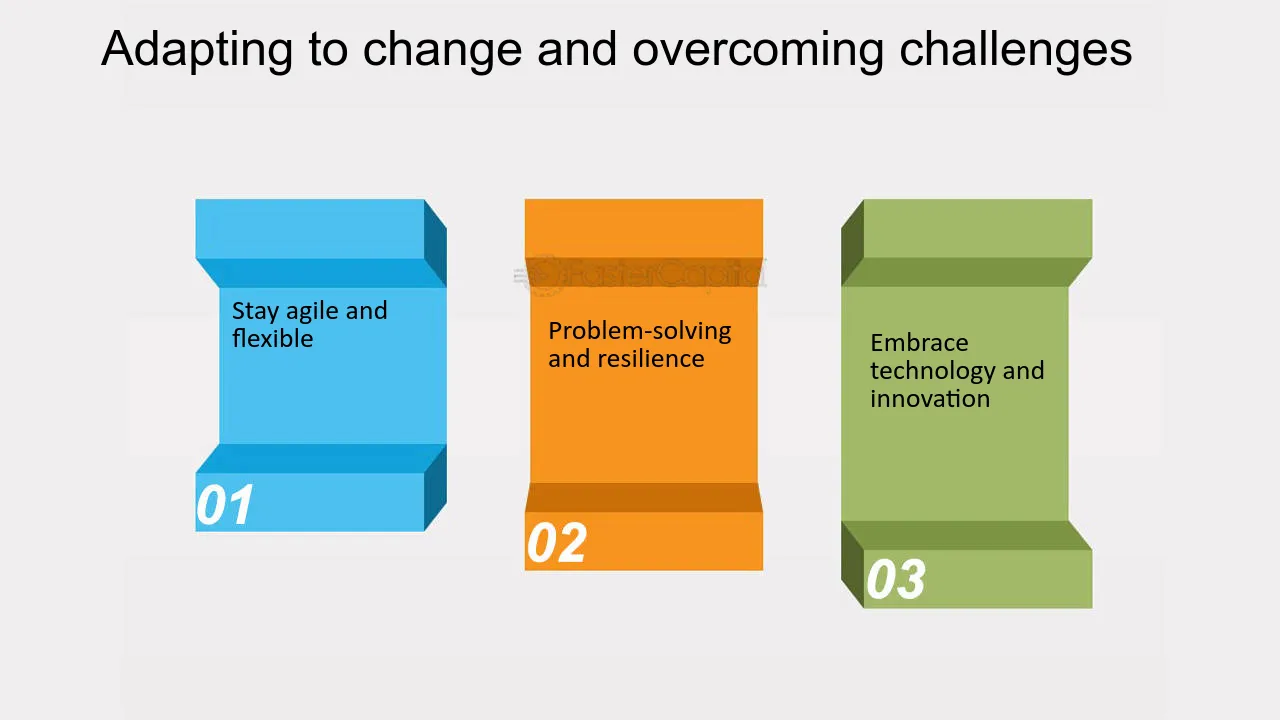
Adapting to change and overcoming challenges - The Key to Success for Business Developers
19. Empowering Employees to Drive Change:Overcoming Challenges and Resistance to Intrapreneurship
1. Identify and understand the challenges
The first step in overcoming challenges and resistance to intrapreneurship is to identify and understand them. This requires a deep dive into the organizational culture, mindset, and existing processes.
For example, one common challenge is the fear of failure. Many employees may hesitate to take risks and pursue innovative ideas due to the potential negative consequences. To address this challenge, organizations can create a supportive environment that encourages experimentation and learning from failures. They can also provide resources and training to help employees develop the skills and confidence needed to take on intrapreneurial projects.
2. Foster a culture of innovation
Creating a culture of innovation is crucial for overcoming resistance to intrapreneurship. This includes promoting open communication, trust, and collaboration among employees. It also involves recognizing and rewarding innovative ideas and initiatives.
For instance, companies like Google and 3M have implemented programs that allow employees to spend a percentage of their time working on personal projects. This not only fosters creativity and intrapreneurship but also encourages employees to think outside the box and come up with new ideas.
3. Provide resources and support
Intrapreneurial initiatives often require resources and support from the organization. This can include financial backing, access to relevant data and information, and guidance from experienced mentors or advisors.
Take the example of Amazon's "Just Do It" program, where employees are given the authority and resources to pursue innovative projects without seeking approval from higher-ups. This program empowers employees to take ownership of their ideas and provides them with the necessary resources to bring them to fruition.
4. Break down silos and encourage cross-functional collaboration
Silos and departmental barriers can hinder intrapreneurial efforts. Overcoming resistance to intrapreneurship requires breaking down these silos and promoting cross-functional collaboration.
For example, companies like Zappos have implemented a holacratic organizational structure, where employees are organized into self-managed teams rather than traditional departments. This structure encourages collaboration and allows employees to work on projects that align with their skills and interests, regardless of their functional area.
5. Communicate the benefits and impact of intrapreneurship
Resistance to intrapreneurship can often stem from a lack of understanding of its benefits and potential impact. It is crucial for organizations to communicate the value of intrapreneurial initiatives and how they align with the overall goals and strategy of the company.
One way to do this is by sharing success stories and case studies of intrapreneurial projects that have had a positive impact on the organization. This helps employees see the tangible benefits of intrapreneurship and motivates them to overcome resistance and embrace innovation.
In conclusion, overcoming challenges and resistance to intrapreneurship requires a holistic approach that addresses both the cultural and structural aspects of the organization. By identifying and understanding the challenges, fostering a culture of innovation, providing resources and support, encouraging cross-functional collaboration, and communicating the benefits, organizations can empower their employees to drive change and unleash their intrapreneurial potential.
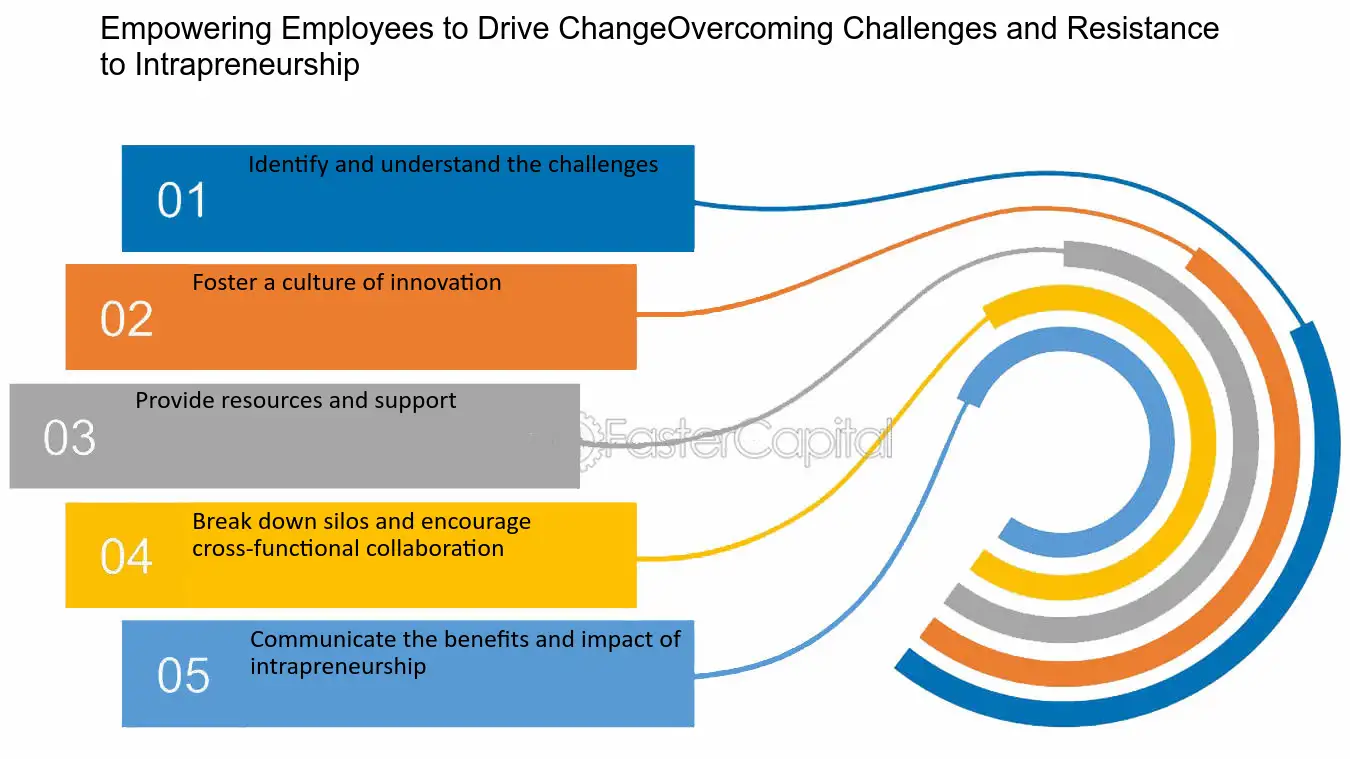
Empowering Employees to Drive Change:Overcoming Challenges and Resistance to Intrapreneurship - The Ultimate Guide to Intrapreneurship: Empowering Employees to Drive Change
20. Embracing Change: Overcoming Resistance and Fears
3. Embracing Change: Overcoming Resistance and Fears
Change can be an intimidating prospect for many individuals. It often brings uncertainty and disrupts the comfort zone we have grown accustomed to. Whether it is a career change, a new relationship, or a major life decision, the fear of the unknown can paralyze us and prevent us from taking the necessary steps towards personal transformation. However, it is important to remember that change is inevitable, and embracing it is crucial for growth and self-development. In this section, we will explore different strategies to overcome resistance and fears associated with change, providing insights from various perspectives and highlighting the importance of embracing change.
1. Acknowledge and accept your fears: The first step in overcoming resistance to change is to acknowledge and accept your fears. It is natural to feel anxious or uncertain when faced with the unknown. By recognizing these emotions and accepting them as a normal part of the process, you can begin to address them and work through them more effectively. For example, if you are considering a career change but are afraid of failure or financial instability, acknowledging these fears will allow you to explore them further and find ways to mitigate the risks involved.
2. Challenge your limiting beliefs: Often, our fears and resistance to change are rooted in limiting beliefs that hold us back. These beliefs can stem from past experiences, societal expectations, or even self-imposed limitations. By challenging these beliefs and questioning their validity, we can open ourselves up to new possibilities and opportunities. For instance, if you believe that you are not talented enough to pursue a creative endeavor, you can challenge this belief by seeking out success stories of individuals who started with limited skills but achieved great things through perseverance and hard work.
3. Seek support and guidance: Going through a major transformation alone can be overwhelming. seeking support and guidance from trusted friends, family members, or professionals can provide a valuable source of encouragement and advice. Surrounding yourself with a supportive network can help alleviate fears and provide a sense of security during times of change. For example, if you are considering ending a toxic relationship but are hesitant due to the fear of being alone, seeking guidance from a therapist or support group can offer valuable insights and help you navigate through the process.
4. Take small steps and celebrate progress: Change does not happen overnight, and it is important to remember that progress is not always linear. Breaking down your transformation into smaller, manageable steps can make the process less overwhelming and more achievable. Celebrating each milestone along the way can also boost your motivation and confidence. For instance, if you are trying to adopt a healthier lifestyle, start by incorporating small changes such as taking a daily walk or swapping sugary snacks for healthier alternatives. Acknowledge and celebrate each small step towards your goal, as it brings you closer to the overall transformation.
5. Embrace a growth mindset: embracing change requires adopting a growth mindset, which is the belief that our abilities and intelligence can be developed through dedication and hard work. This mindset allows us to view challenges as opportunities for growth rather than obstacles. By embracing a growth mindset, we can approach change with a sense of curiosity and optimism, leading to a more positive and proactive attitude. For example, if you encounter setbacks or obstacles during your transformation journey, instead of viewing them as failures, consider them as valuable learning experiences that will ultimately contribute to your personal growth.
Embracing change is an essential component of personal transformation. By acknowledging and accepting our fears, challenging limiting beliefs, seeking support, taking small steps, and embracing a growth mindset, we can overcome resistance and fears associated with change. Remember, change is not something to be feared, but rather an opportunity for growth and self-discovery. So, take that leap of faith, embrace change, and unlock your true potential for personal transformation.
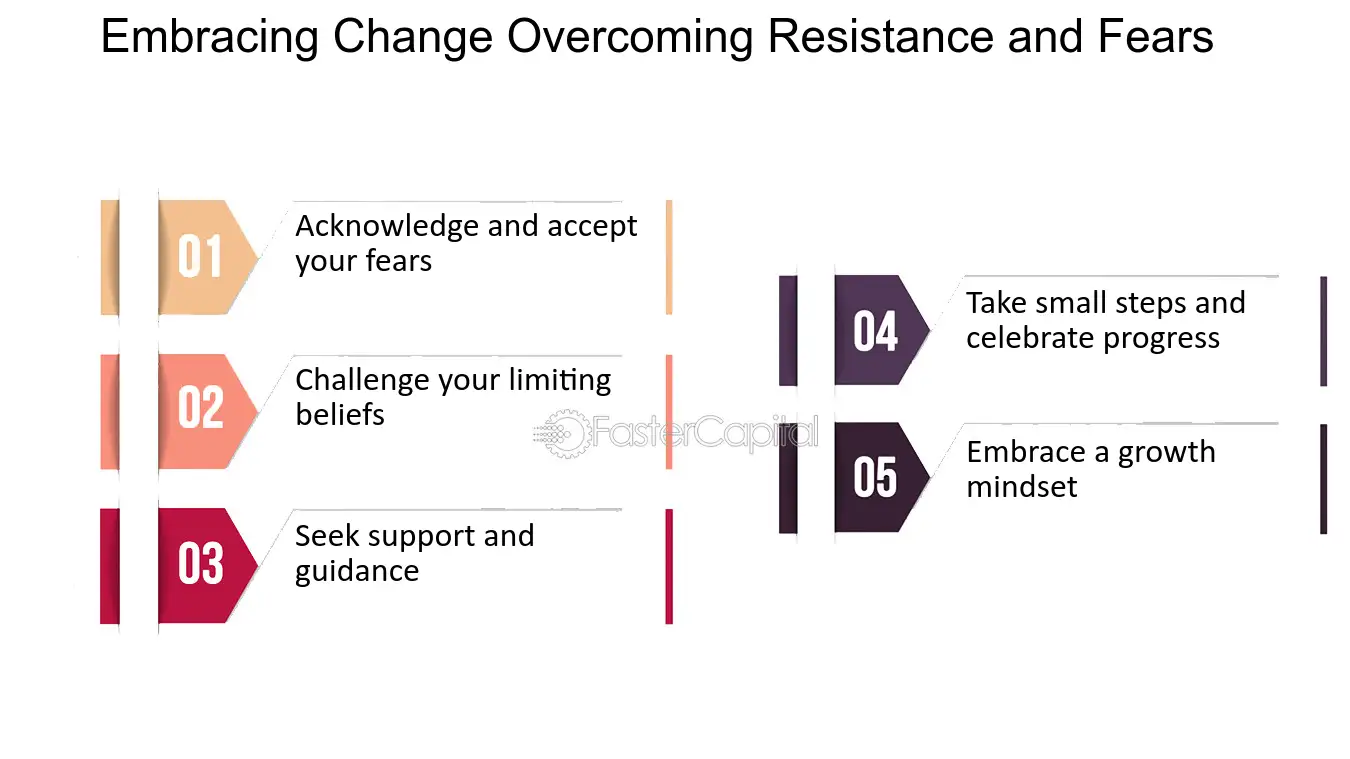
Embracing Change: Overcoming Resistance and Fears - Transformation: The Savior Plan: Unlocking Personal Transformation
21. Embracing Change and Overcoming Fear
Taking risks is something that requires a great deal of courage and determination. It involves stepping outside of one's comfort zone and embracing change. While it can be scary to take risks, doing so is often necessary to achieve success and growth. Whether it's starting a new business venture, moving to a new city, or pursuing a new relationship, taking risks can lead to amazing opportunities and experiences. Of course, there is always the possibility of failure, but it's important to remember that failure is simply a part of the learning process. With the right mindset, taking risks can be a positive and transformative experience.
Here are some insights on taking risks:
1. Fear is a natural response: Fear is a natural response to the unknown, and taking risks often involves stepping into unfamiliar territory. It's important to acknowledge and accept fear, rather than trying to ignore or suppress it. It's okay to feel anxious or scared, but it's important not to let fear hold you back from taking risks.
2. We learn from failure: Failure is not something to be feared, but rather embraced as a learning opportunity. When things don't go as planned, it's important to reflect on what went wrong and what can be done differently in the future. Embracing failure can help build resilience and develop problem-solving skills.
3. Taking risks builds confidence: When we take risks and step outside of our comfort zones, we are often surprised by what we are capable of achieving. Each time we take a risk and succeed, our confidence grows. This newfound confidence can spill over into other areas of our lives, leading to even more success.
4. Regret is worse than failure: The fear of failure can often lead to a life of regret. When we don't take risks, we may miss out on incredible opportunities and experiences. It's important to remember that regret can be a far worse outcome than failure.
Taking risks is an essential part of navigating life's maze. While it can be scary, taking risks can lead to amazing opportunities and experiences. By acknowledging fear, embracing failure, building confidence, and avoiding regret, we can learn to take risks with courage and determination.
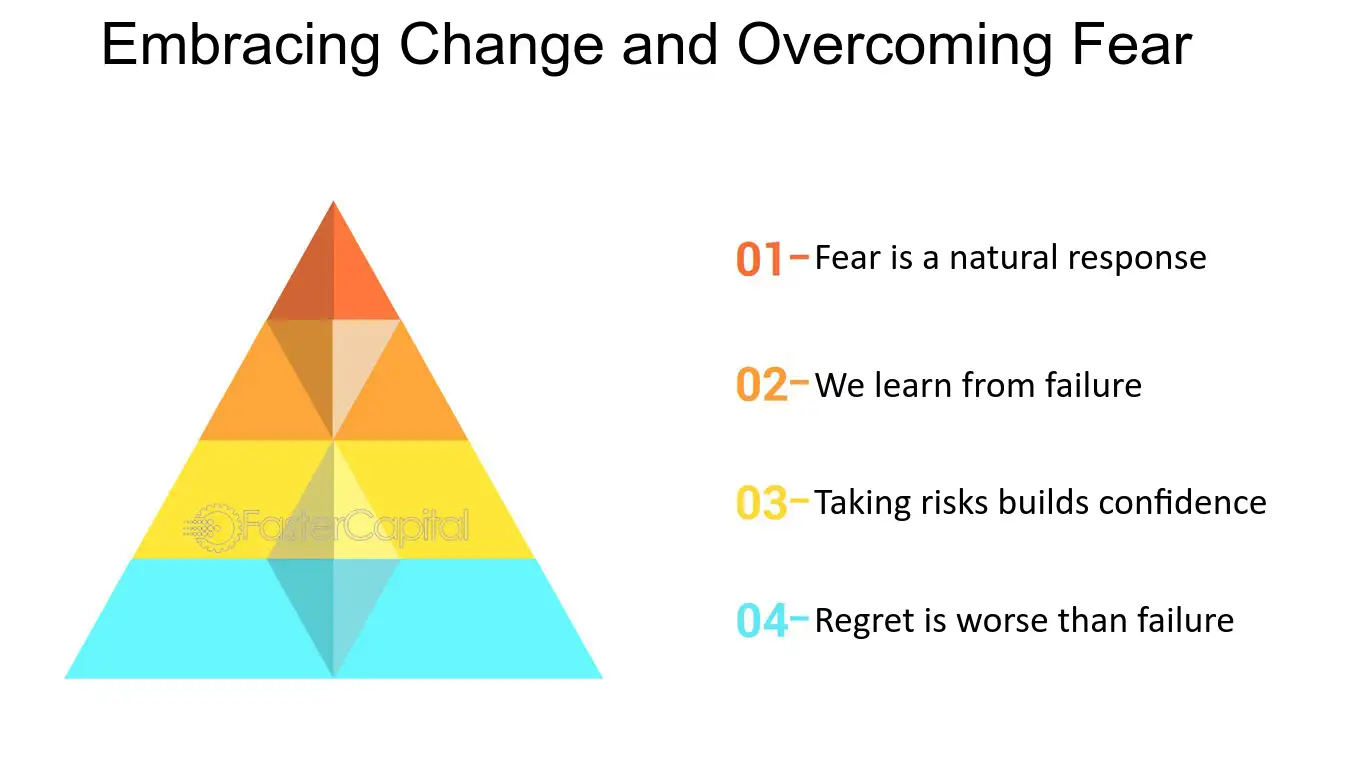
Embracing Change and Overcoming Fear - Vast options: Unlocking the Vast Options: Navigating Life s Maze